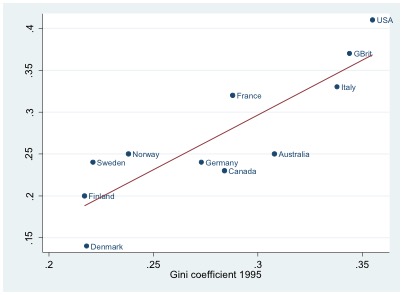
A strong positive correlation between incomes across generations indicates that children from a poor family are likely to be relatively poor as adults and that elite positions are generally held by those from rich backgrounds. This may indicate economic inefficiency, as immobile societies may not allow the most talented the best opportunities.
It is not necessarily true, however, that strong intergenerational persistence implies an absence of equality of opportunity. For example, if children from higher-income families work harder than children from other families, the positive correlation across generations might not necessarily violate principles of equality of opportunity and may be desirable in a society that rewards effort. It is difficult to know the appropriate level of intergenerational persistence, so researchers are increasingly comparing levels across countries, time, and localities. These comparisons are providing new insights into the mechanisms that drive intergenerational mobility.
One common approach looks at the statistical association between income in the household when a child is growing up and the child’s subsequent income. The most common measure is “intergenerational elasticity.” For example, say one father had twice the income of another father. The richer father’s child would have 50% more income than the child of the poorer father if the estimated “elasticity” statistic is 0.5. If the elasticity is zero, it means that the child’s adult income is unrelated to parental status, implying a perfectly mobile society.
International comparisons of intergenerational persistence consistently identify some nations, particularly the Nordics, as having rather low persistence, while others, notably the US, are more stratified. The figure above charts intergenerational persistence against a standard measure of income inequality, the Gini coefficient. It reveals that less mobility is associated with more inequality. This relationship is called “The Great Gatsby curve,” after the eponymous novel. Of course, as is frequently noted, correlation does not imply causality. To prove that reducing income inequality would reduce persistence (improve mobility) requires more evidence.
If there was a causal relationship between them, intergenerational persistence would be expected to rise for cohorts affected by rising income inequality. So far, however, evidence on this is inconsistent in the US. In the UK, there is some evidence suggesting a rise in intergenerational persistence as inequality rose during the late 1970s and 1980s.
An alternative approach looks at local areas. An important study by Raj Chetty and co-authors (2014) relates the extent of intergenerational persistence to inequality at the US local level and to several other local characteristics. It thus distinguishes the impact of inequality from that of other factors and finds some evidence that narrowing the gap between rich and poor would reduce intergenerational inequality.
The relationship between inequality and intergenerational persistence is only part of the story why societies vary in their social openness. Researchers are developing their understanding of intergenerational relationships by pursuing new data and measures as well as trying to understand how specific policy changes affect the extent of mobility. This is important research, because the extent to which advantage and disadvantage persist across society is a vital element of the shape of society, its vibrancy, and its success.
© Jo Blanden
Jo Blanden's full article "Intergenerational income persistence" is available here.
Read more of our articles on economic inequality.
References
Chetty, R., N. Hedren, P. Kline, and E. Saez. "Where is the land of opportunity? The geography of intergenerational mobility in the United States." The Quarterly Journal of Economics 129:4 (2014): 1553–1623.
Figure: The Great Gatsby curve: Intergenerational elasticity is positively associated with the Gini coefficient of inequality for many countries for cohorts born in the 1960s and 1970s
Source: Gini coefficients for 1995 are from the Luxemburg Income Study.
Please note:
We recognize that IZA World of Labor articles may prompt discussion and possibly controversy. Opinion pieces, such as the one above, capture ideas and debates concisely, and anchor them with real-world examples. Opinions stated here do not necessarily reflect those of the IZA.